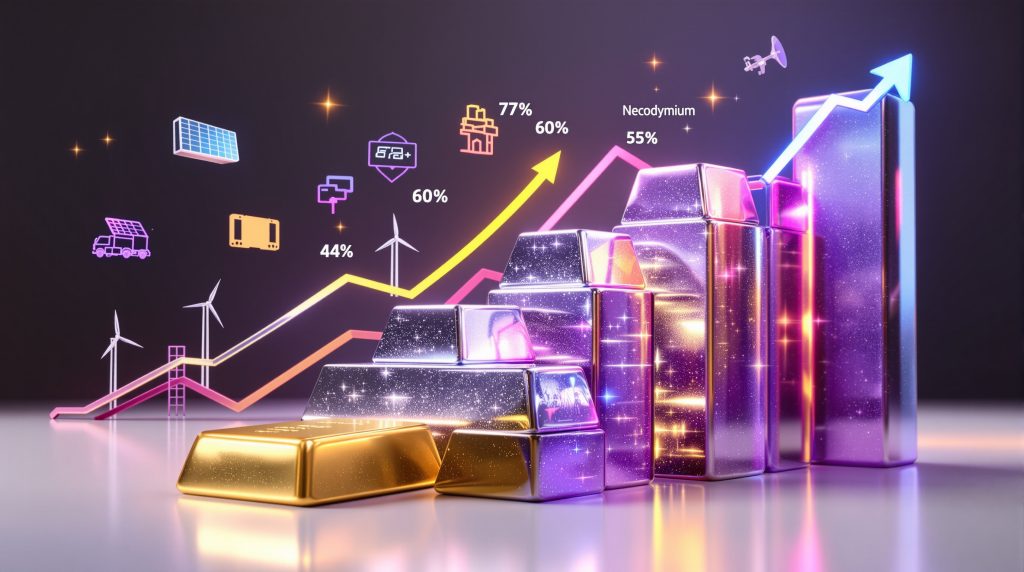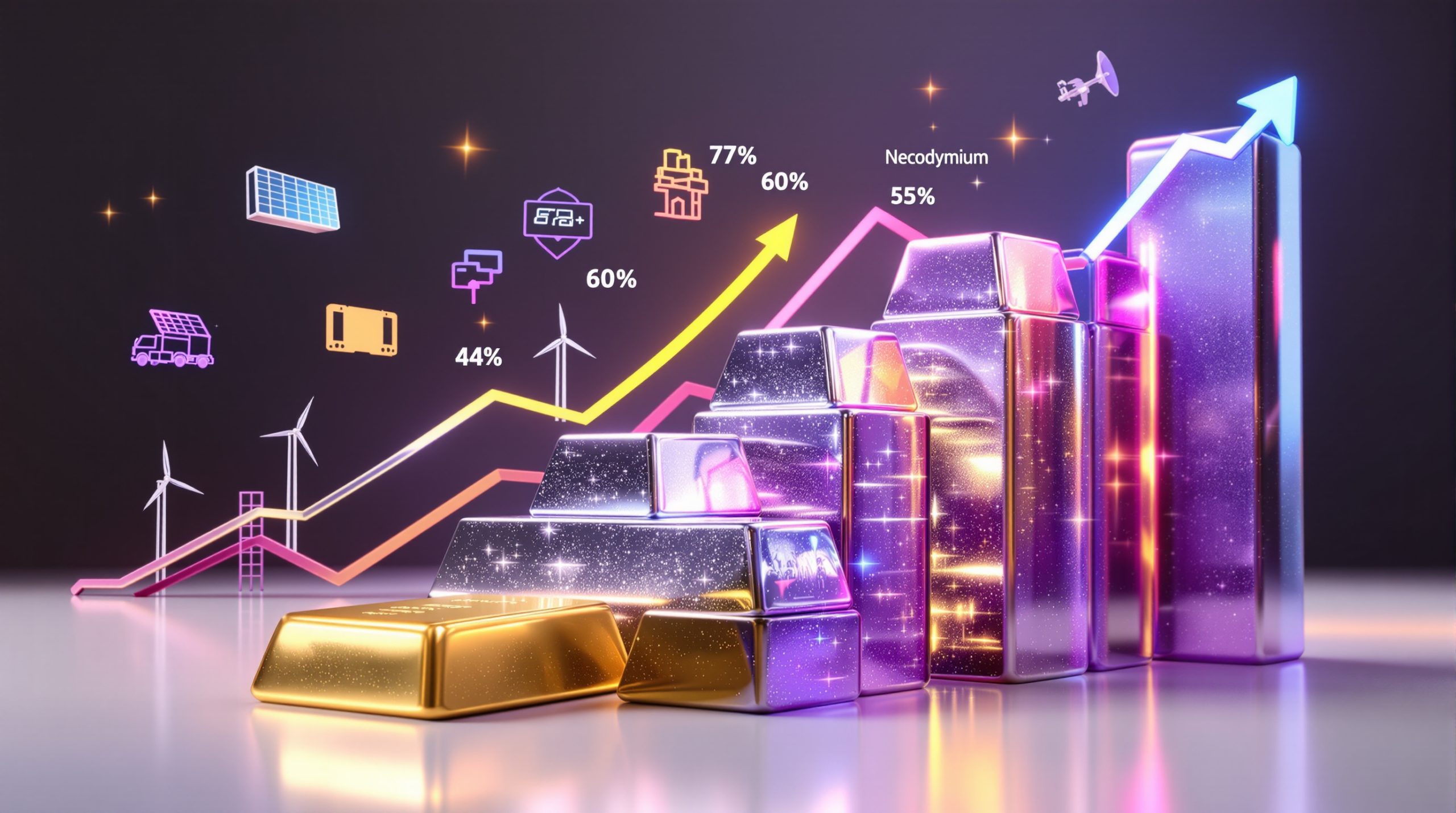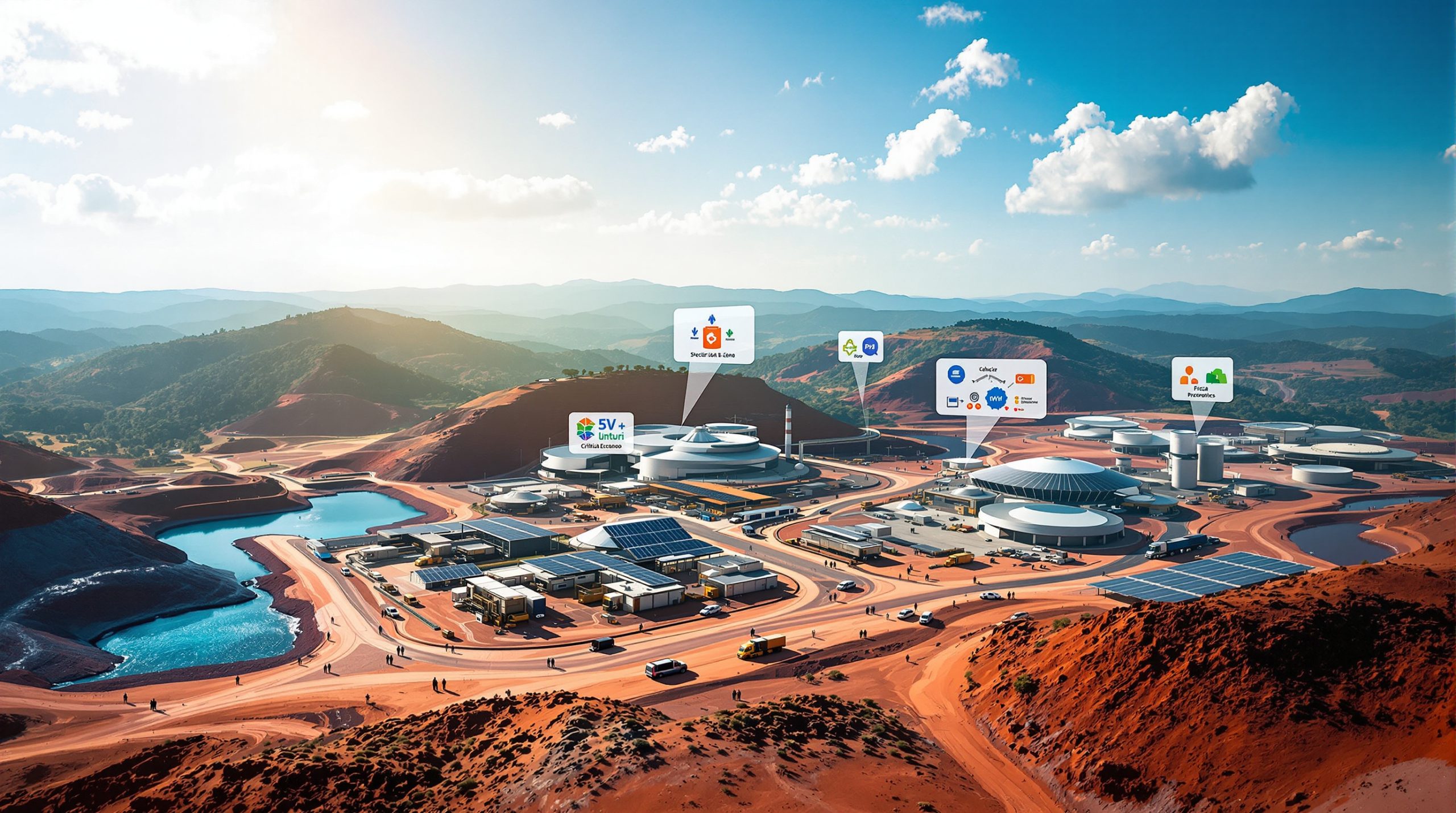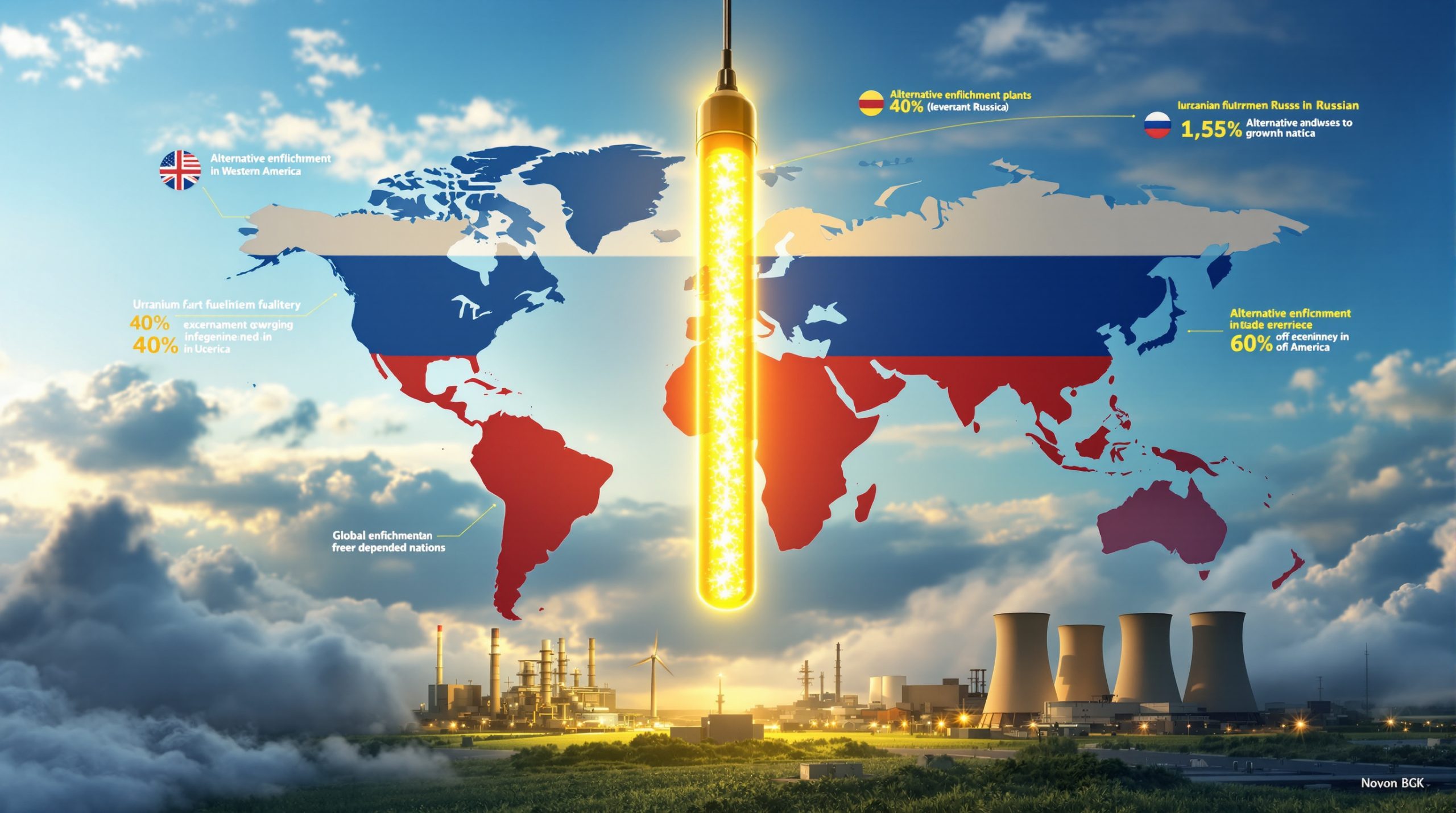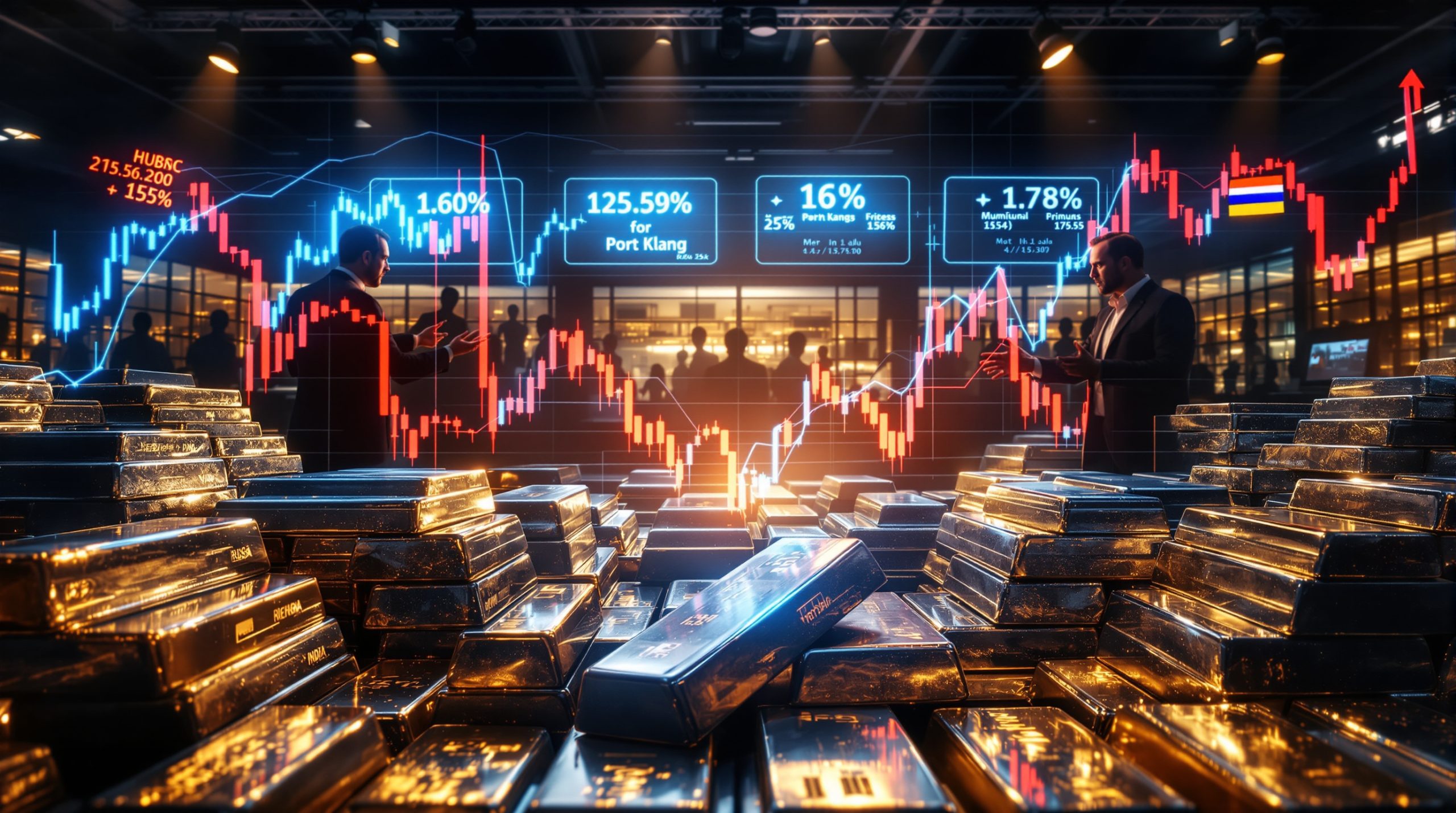Strategic Metals Outshining Gold in 2025: The Rise of Critical Resources
While gold has captured financial headlines with its impressive rally to unprecedented heights, three strategic metals have quietly delivered even stronger performance. These metals—platinum, silver, and neodymium—have outpaced gold's 44% year-to-date gains with returns ranging from 58% to 77%, driven by industrial demand, supply constraints, and technological advancement rather than traditional safe-haven investing.
The remarkable performance of these strategic metals highlights a fundamental shift in metals markets as industrial applications create compelling investment opportunities beyond traditional precious metals.
How Industrial Demand is Reshaping Metal Markets
The Technology-Driven Metals Revolution
Strategic metals are experiencing unprecedented demand growth due to their essential roles in emerging technologies. Unlike gold, which primarily serves as a store of value and inflation hedge, these metals have become critical components in renewable energy, electric vehicles, electronics, and other high-growth industries.
This industrial utility creates a fundamentally different demand profile compared to gold:
| Metal | YTD Price Increase | Primary Industrial Applications |
|---|---|---|
| Platinum | 77% | Catalytic converters, fuel cells, electronics |
| Silver | 60% | Solar panels, electronics, medical devices |
| Neodymium | 58% | Permanent magnets for EVs and wind turbines |
| Gold | 44% | Investment, jewelry, limited industrial use |
Supply Constraints Amplifying Price Movements
All three outperforming metals face significant supply constraints that have intensified their price appreciation:
- Platinum: Currently experiencing its third consecutive year of supply deficit
- Silver: Production challenges and increasing industrial demand creating market imbalance
- Neodymium: Limited mining operations and complex extraction processes restricting new supply
These supply limitations, combined with accelerating demand, have created particularly favorable pricing environments compared to gold, which has more diversified and stable production channels.
Which Strategic Metals are Leading the Charge?
Platinum: The Industrial Precious Metal
Platinum has emerged as the standout performer among strategic metals in 2025, with prices surging approximately 77% since January to exceed US$1,500 per ounce. This remarkable performance stems from:
- Persistent supply deficits for three consecutive years
- Expanding applications beyond traditional catalytic converters
- Growing demand from hydrogen fuel cell technology
- Limited global production concentrated in South Africa and Russia
The metal's unique physical and chemical properties make it irreplaceable in numerous applications, from medical implants to chemical processing catalysts, creating inelastic demand even as prices rise.
Silver: The Renewable Energy Enabler
Silver has delivered approximately 60% returns since January 2025, reaching over US$46 per ounce. While traditionally viewed alongside gold as a precious metal, silver's industrial applications have become the primary driver of its outperformance:
- Essential component in photovoltaic cells for solar energy
- Critical material in electronics manufacturing
- Growing use in medical applications and antimicrobial products
- Relatively limited new mining development despite rising demand
The green energy transition has particularly benefited silver, with each gigawatt of solar capacity requiring substantial silver inputs—approximately 15-20 grams per solar panel. This creates structural demand growth that exceeds current production capabilities.
Neodymium: The EV and Renewable Energy Catalyst
Neodymium, a rare earth element, has risen 58% in 2025, outpacing gold despite receiving far less mainstream attention. This performance reflects:
- Essential role in manufacturing permanent magnets for electric motors
- Critical component in wind turbine generators
- Growing demand from consumer electronics
- Concentrated production primarily in China and Australia
The electrification of transportation and expansion of renewable energy generation have created sustained demand growth for neodymium, while production remains constrained by complex processing requirements and environmental considerations.
How Can Investors Gain Exposure to These Strategic Metals?
ASX Investment Options for Strategic Metals
Australian investors seeking exposure to these outperforming strategic metals have several options on the ASX, though choices are more limited than for gold:
Platinum Exposure
The Global X Physical Platinum Structured (ASX: ETPMPT) ETF offers direct exposure to platinum price movements through physical metal backing. This ETF has delivered approximately 60% returns year-to-date, closely tracking the underlying metal's performance while providing investors with a convenient, exchange-traded investment vehicle.
Silver Exposure
The Global X Physical Silver Structured (ASX: ETPMAG) ETF provides similar exposure to silver price movements. This ETF aims to mirror silver spot prices in Australian dollars (minus fees) and has risen 45% in 2025, offering investors a straightforward way to participate in silver's outperformance.
Rare Earth Elements Exposure
For exposure to neodymium and other rare earth elements, Lynas Rare Earths Ltd (ASX: LYC) stands out as Australia's premier option. The company operates the Mt Weld mine in Western Australia, one of the world's highest-grade rare earth deposits, and maintains processing facilities in Malaysia.
Lynas has been the standout performer among these strategic metal investments, with its shares surging 159% in 2025 to reach $16.90. This exceptional performance reflects both rising rare earth prices and the company's strategic positioning in a sector with limited investment options.
Investment Considerations for Strategic Metals
When considering strategic metal investments, several factors differentiate them from traditional gold investments:
-
Industrial demand sensitivity: Strategic metals are more exposed to economic cycles and specific industry trends than gold
-
Supply chain complexity: Understanding processing, refining, and manufacturing dependencies is crucial
-
Geopolitical factors: Production concentration creates unique risks, particularly for rare earths
-
Market liquidity: These markets are typically smaller and less liquid than gold markets
-
Long-term structural trends: Clean energy transition and electrification provide multi-decade demand drivers
What's Driving the Divergence Between Strategic Metals and Gold?
Different Fundamental Drivers
While gold's 2025 rally has been impressive, its performance drivers differ fundamentally from those propelling strategic metals outperforming gold:
| Metal Type | Primary Price Drivers | Secondary Factors |
|---|---|---|
| Gold | Monetary policy, inflation expectations, geopolitical risk | Limited industrial demand, jewelry consumption |
| Strategic Metals | Industrial demand, supply constraints, technological adoption | Investment demand, production costs |
This divergence explains why strategic metals have outpaced gold despite the latter's strong performance. While gold responds primarily to macroeconomic and geopolitical factors, strategic metals reflect tangible industrial demand growth and physical supply limitations.
The Supply-Demand Imbalance
All three outperforming strategic metals share a common characteristic: persistent supply-demand imbalances that exceed those in the gold market:
- Platinum's third consecutive deficit year has depleted above-ground inventories
- Silver's industrial applications continue to expand faster than mining output
- Neodymium production constraints amid accelerating demand from EVs and wind energy
These imbalances create price appreciation potential that exceeds what's typically possible in the more balanced gold market, where substantial above-ground inventories and diversified production sources moderate price movements.
What Does the Future Hold for Strategic Metals vs. Gold?
Long-Term Outlook for Strategic Metals
The fundamental drivers supporting strategic metal outperformance appear sustainable over the medium to long term:
- Accelerating clean energy transition driving demand for silver and rare earths
- Transportation electrification creating persistent neodymium demand growth
- Hydrogen economy development supporting platinum applications
- Limited new production capacity coming online in the near term
These factors suggest strategic metals may continue to offer compelling investment opportunities, potentially outperforming gold over extended periods despite inevitable market volatility.
Portfolio Diversification Benefits
For investors seeking portfolio diversification beyond traditional precious metals, strategic metals offer exposure to different economic drivers and technological trends:
- Reduced correlation with broad market movements compared to equities
- Exposure to specific growth sectors like renewable energy and electrification
- Inflation protection similar to gold but with additional industrial demand drivers
- Supply constraint premium that can amplify returns during technological transition periods
The increasing focus on critical minerals supply crisis has further highlighted the strategic importance of these metals in global supply chains.
How to Build a Strategic Metals Investment Strategy
Balancing Exposure Across Metal Types
A balanced approach to strategic metals investing might include:
-
Physical metal ETFs for direct price exposure with liquidity advantages
-
Specialized producers like Lynas for operational leverage to price movements
-
Diversified miners with strategic metal exposure for reduced single-commodity risk
-
Technology companies that benefit from strategic metal applications for indirect exposure
Risk Management Considerations
Investors should consider several risk factors when allocating to strategic metals:
- Price volatility typically exceeds that of gold, requiring appropriate position sizing
- Technological disruption could eventually reduce demand for specific metals
- Substitution risk as high prices incentivize alternative material development
- Regulatory changes affecting mining, processing, or end-use applications
- Market liquidity constraints during periods of market stress
Furthermore, understanding Australia's critical minerals reserve policy can provide insights into potential government actions that might affect supply and pricing.
FAQ: Strategic Metals as Investment Opportunities
What makes strategic metals different from traditional precious metals?
Strategic metals derive their value primarily from industrial applications rather than monetary or jewelry demand. Their prices respond more directly to technological developments, manufacturing trends, and specific supply constraints than to broad macroeconomic factors like interest rates or inflation expectations.
Why have strategic metals outperformed gold in 2025?
The combination of accelerating industrial demand from clean energy, electrification, and advanced manufacturing, coupled with persistent supply constraints, has created favorable pricing environments for strategic metals. Gold, while benefiting from macroeconomic uncertainty, lacks the same degree of structural supply-demand imbalance.
Are strategic metals suitable for all investors?
Strategic metals typically exhibit higher volatility than gold and may be less appropriate for conservative investors. However, for those seeking diversification and exposure to technological growth trends, a measured allocation to strategic metals can enhance portfolio performance and reduce correlation with traditional assets.
What are the key risks of strategic metal investments?
Key risks include price volatility, technological substitution, production increases resolving supply constraints, and potential economic slowdowns reducing industrial demand. These metals also tend to have less liquid markets than gold, potentially amplifying price movements during market stress.
Strategic Metals as Complement to Traditional Precious Metals
While gold continues to play a vital role in investment portfolios, the outperformance of strategic metals highlights the potential benefits of broader metals exposure. Platinum, silver, and neodymium have each delivered returns exceeding gold's impressive rally, driven by fundamentally different factors that may continue to support outperformance.
For investors seeking to capitalize on technological transitions while maintaining precious metal exposure, a balanced approach incorporating both traditional and strategic metals may provide optimal results. The structural demand growth for these critical materials strategy, combined with persistent supply constraints, creates a compelling investment case beyond traditional gold allocation.
As the global economy continues its transition toward electrification, renewable energy, and advanced manufacturing, strategic metals are likely to remain essential components of the industrial landscape—potentially rewarding investors who recognize their importance ahead of broader market awareness.
The ongoing transition to cleaner energy sources has particularly accelerated demand for energy transition metals, creating supply-demand dynamics favorable to investors in this sector.
Disclaimer: The information provided in this article is general in nature and does not consider your personal financial situation. It is not intended as financial advice, and you should seek professional advice before making any investment decisions based on the information contained herein. Past performance is not necessarily indicative of future returns, and all investments carry risk.
Want to Catch the Next Major Mineral Discovery?
Discovery Alert's proprietary Discovery IQ model delivers instant notifications on significant ASX mineral discoveries, helping investors identify opportunities in strategic metals and other resources before the broader market. Visit the Discovery Alert discoveries page to see how early identification of major discoveries can lead to exceptional investment returns.
